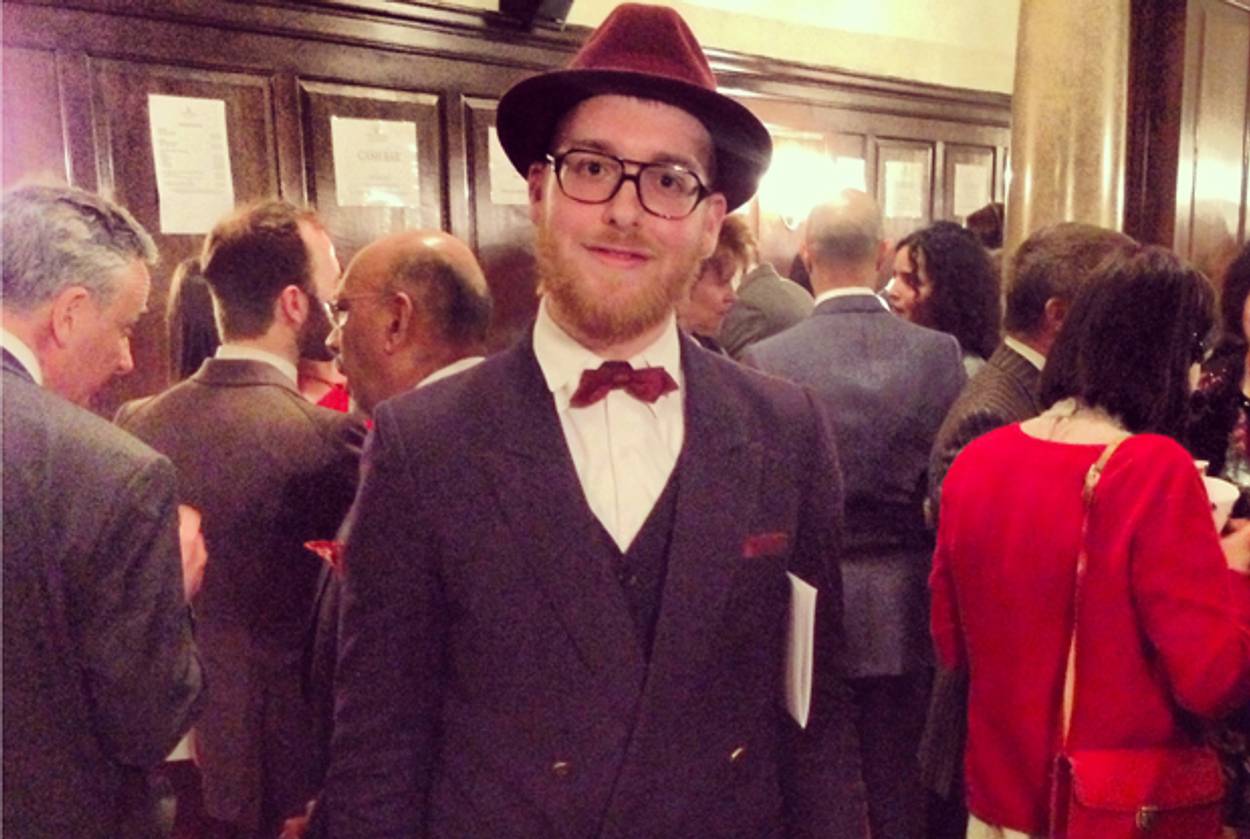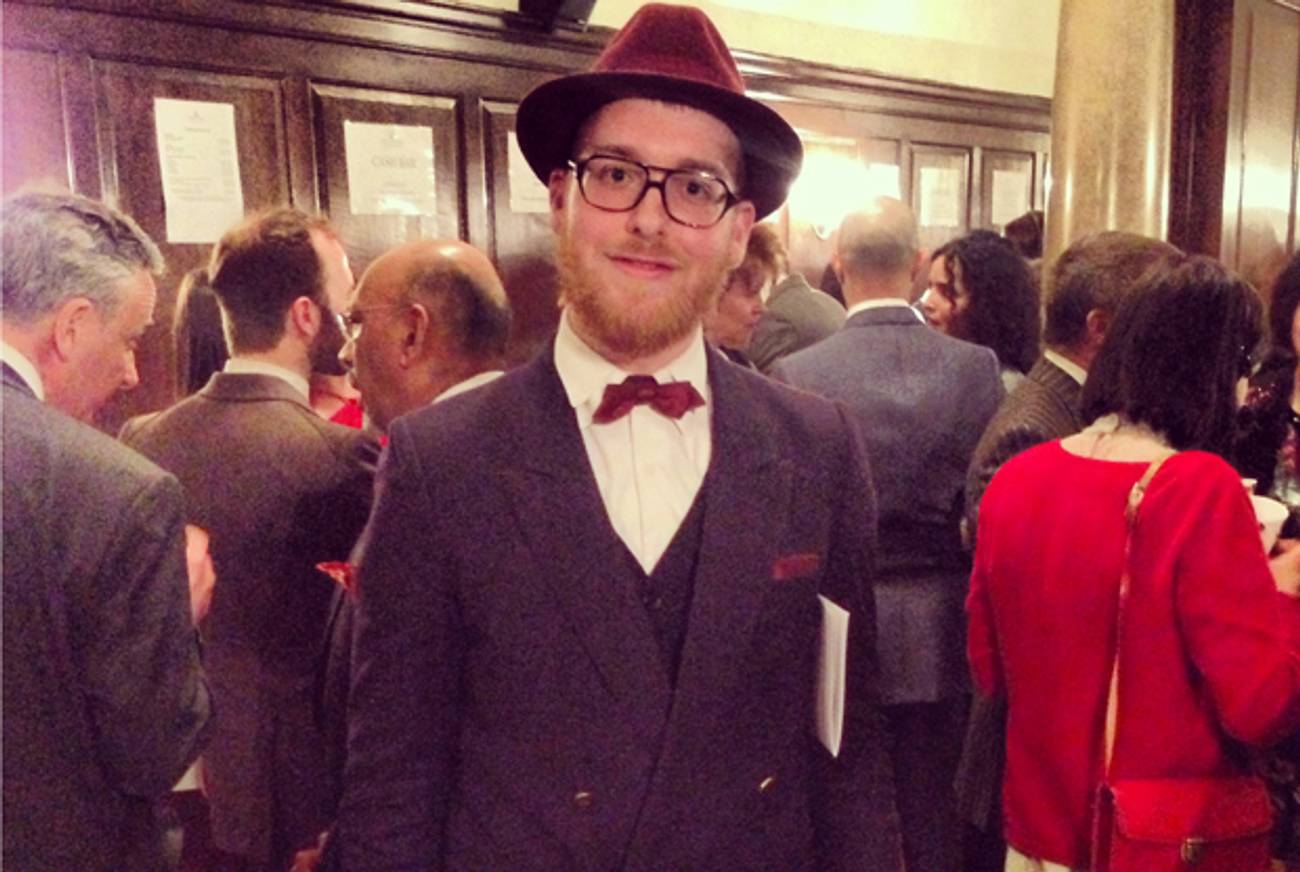On Savile Row, A Rabbi Hones His Craft
An apprentice tailor, Yosel Tiefenbrun mixes the sartorial with the spiritual




It’s not every day that a rabbi gets photographed by a GQ editor, kicking off a flurry of media attention after his on-trend ensemble appeared on Instagram. But 24-year old Londoner Yosel Tiefenbrun isn’t your typical rabbi. When the Chabadnik isn’t filling in for rabbis or serving as a cantor in his father’s synagogue, he’s welcoming customers to a 75-year-old tailoring house on Savile Row or bent over a sewing machine in the back of the shop.
Born in Brooklyn, NY, Tiefenbrun moved to London as a child, where his obsession with style began at an early age. “When I was a little boy, we used to get suits before the High Holidays and Pesach,” he told me. “I used to really take care of them to make sure they were perfect, my shoes were shined. I didn’t want even a scratch on them.”
“I always dreamt as a child of having my own brand,” he added.
Tiefenbrun’s story has the usual beginning, born to a rabbi, raised to be a devout Lubavitcher, attending yeshiva in New York, Israel, and France. After his ordination, Tiefenbrun spent two years working as a rabbi in Singapore. During that time, he balanced rabbinical work with an interior design course to pursue his passion—or at least a form of it.
“I thought for a religious Jew it might be difficult to enter fashion school, so I tried interiors,” he explained. “But I realized I was incorporating fashion into my drawings.”
As the eldest child, Tiefenbrun’s foray into fashion wasn’t immediately embaced by his parents, but after a while, as he says, “they got used to it.” He went on to learn how to sketch before returning to London, one of the greatest cities for apparel design and craftmanship. But knocking on the doors of Savile Row wasn’t so easy. Though there are a handful of more recent arrivals, most of the tailoring houses with the famous address have been around for hundreds of years—and unlike New York’s Lower East Side in the 19th and 20th century, they’re run by Englishmen with long family histories, not enterprising immigrants. This traditional environment combined with the effects of the recession and the obligatory wages firms must pay trainees makes an apprenticeship a prized possession.
Enter Andrew Ramroop, a Trinidadian master cutter who came to London more than 40 years ago, having never travelled further than a few miles from where he grew up. Like Tiefenbrun, he tried to break through the largely cloistered world of London’s established tailoring houses. Even with years of experience, he struggled to get a foot in any door—until he met Maurice Sedwell. The English tailor had travelled extensively during World War II as an army officer and returned to London with an open mind. Sedwell gave Ramroop the chance that would change his life.
“I was turned down for just about every job, even with nine years of experience,” Ramroop explained. “I had a funny accent, my hair grew high, curly and bushy. Employers are afraid of letting anyone in that they feel their customers might not take kindly to.” Status, it seemed, trumped skill. “Even in this century, I was offered backroom jobs only, despite have glowing qualifications,” he said. “Maurice Sedwell is the only one who gave me a job.” Ramroop would also become the person Sedwell sold his business to when he eventually retired in 1988.
Ramroop now owns Maurice Sedwell and runs the Savile Row Academy, ushering in a new generation of finishers, cutters, and fitters. He saw something in Tiefenbrun and broke with traditional academy policy, offering the rabbi an apprenticeship at Maurice Sedwell even before he graduated.
“Yosel is unique, that’s his value,” Ramroop told me. That unique style is what got Tiefenbrun noticed by GQ’s online fashion editor Nick Carvell at London’s Golden Shears awards in May. The industry event happens every two years, and Tiefenbrun went by chance after a colleague backed out at the last minute. He wasn’t up for an award, but he earned a serious distinction when Carvell posted his noteworthy outfit on Instagram and Twitter.
“I just thought he looked good,” Carvell explained. “His heritage helped him tick the beard trend, and his outfit looked really good.” It was Tiefenbrun’s curatorial instincts, though, and not his unusual background, that got Carvell’s attention. “I didn’t know anything about him, I just thought he dressed really impeccably,” Carvell added. “It was the combination of him wearing the on-trend claret color, which is going to be very big this season, and we don’t see a Trilby hat very often and he wore it well.”
Since then, the rabbi and his Trinidadian mentor have been courted by the British press. When asked whether Ramroop’s own struggle to break into the industry played a part in his decision to take Tiefenbrun on as a protégé, the master tailor simply smiles. Tiefenbrun is an enthusiastic student—a look at his Twitter and Tumblr accounts reveal images of him in casual, fashionable, unrabbinical duds posing on Laguna Beach, or a leather pocket square accompanied by the caption “Shabbat Shalom.”
His tweets represent his carefully balanced life–by day practicing his trade, crafting suits worth thousands of dollars. He mingles with a rich sartorial history, dressing some of the world’s wealthiest people. By night he’s busy planning sermons and preparing for Shabbat services. And as Tiefenbrun explains, his focus on finery fits seamlessly with his respect for religion.
“Wearing beautiful clothing has always been important for the High Holidays,” he said. “You’re supposed to wear your best clothes when you’re praying; from your shoes to your hat, you’re supposed to wear something special.” Ramroop interjects: “It’s not just the Jewish religion, think of all those who wear their Sunday best to church.”
Clothes may complement the man, but in the refined, subdued elegance of Savile Row, the Trinidadian and Lubavitcher make a perfect pair.
Amy Guttman is a multimedia journalist who has written and reported for CBS News, NPR, Monocle, Associated Press, and others. She is based in London.